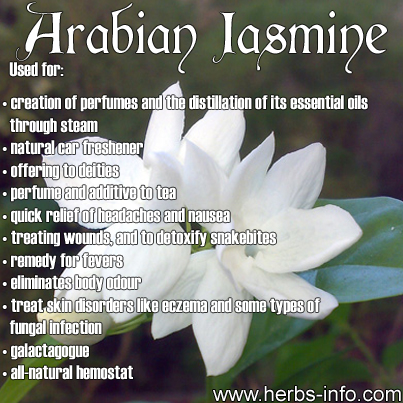Arabian Jasmine

Arabian Jasmine - Uses and Benefits
Infographic: herbshealthhappiness.com. Photo: Jun's World - via Wikipedia - lic. under CCA 2.0

Arabian Jasmine - Botany And History
Sambac jasmine, or Arabian jasmine as it is often referred to, is a native species of jasmine found in the Southern and Southeastern parts of Asia, where it has been used as an ornamental, ceremonial, and medicinal plant for upwards of five-hundred years. Originally harvested wild by early civilizations, it has since been cultivated by a number of cultures mainly for its fragrant flowers, which have been employed since ancient times as a perfume and an incense, as well as for its medicinal leaves and flowers. It is the national flower of the Philippines.
Contrary to its name, Arabian jasmine was not originally cultivated in Arabia, although its associations with the place may have something to do with its popularity with the Indian communities in Arabia, who chiefly employ the plant as a perfume and incense, and as an article for religious ceremonies as well as the possibility of its being popularized within the area by mendicant Persians who held the plant's aroma in high esteem. Arabian jasmine is characterised by its shrub-like appearance. It is a small, compact plant typically growing (at the most) three metres tall, and is replete with very fragrant small white to ivory-hued flowers and tiny, broad, glossy leaves[1].
Arabian Jasmine - Herbal Uses
Arabian jasmine is chiefly employed as an ornamental flower, especially when grown in gardens – typically in small plots, as they readily scent the area with their exquisite aroma once the flowers are in bloom. Just like jasmine-proper (Jasminum officinale) however, Arabian jasmine is also cultivated for its flowers, which have been employed since ancient times for a wide variety of purposes.
The most common use of Arabian jasmine blossoms is in the creation of perfumes and the distillation of its essential oils through steam. In earlier times, the essence of the flower was usually obtained through enflourage or slow maceration in a base oil, although nowadays, it is obtain through more modern methods. Aside from its use as a perfume, Arabian jasmine blossoms are usually cultivated and collected by small families or individuals are strung up into strings to be sold on the streets as a natural car freshener, or as an offering to deities, as is commonly practiced in several parts of India, Indonesia, and the Philippines[2].
Among the most well-known uses of its blossoms however is as a perfume and additive to tea. In Chino-Philippine communities, and in Indo-Filipino groups, Arabian jasmine is typically mixed with green tea (Camellia sinensis) to boost its aroma and to improve its flavour. This version of 'jasmine tea' is typically served in traditional Chinese tea shops or similarly themed restaurants.
Medicinally, Arabian jasmine has been used by many an herbalist, typically to promote the quick relief of headaches and nausea through inhaling its soothing aroma. The roots of the plant were used by Filipino witchdoctors and shamans to treat wounds, and to detoxify snakebites by chewing the dried or fresh root and applying the macerated material directly unto the wound. Many Filipino tribes have employed a strong decoction of its leaves and flowers as a remedy for fevers, as well as an overall body and hair rinse that not only imbues one's person with its unique and attractive scent, but effectively eliminates body odour and helps to treat skin disorders like eczema and some types of fungal infection. A mild tea made from an infusion of either the flowers or the leaves have been used in both Traditional Chinese Medicine and Filipino herbal medicine as a galactagogue. The leaves and the roots of the plant, when pounded, may even be used as a ready all-natural hemostat, or, if mixed with coconut oil or some other base oil, as a poultice to help in bone-setting[3].
In folkloric Filipino medicine, the leaves and the flowers of the plant were believed to improve the attractiveness of a woman, and so bruised or pounded leaves and flowers, or an oil infused with the essence of its flowers were not simply used to scent one's person, but was rubbed on the breasts and privates of a woman to 'increase her desirability'. This oil has also been used to scent hair, and is employed by both men and women of many tribes, usually mixed with other sweet-smelling flowers like hibiscus and lilac. The leaves and flowers are commonly employed while still fresh, although dried flowers used to flavour drinks, and to make medicated rinses, tisanes, and even douches can also be made[4]. A very mild decoction of the flowers may be used as eye drops to treat sore eyes, conjunctivitis, and minor problems with vision, while powdered dried flowers mixed with potassium alum or talcum may be used as a natural deodorant and bath salt.

Arabian Jasmine - Scientific Studies And Research
Gastroprotective:
A group of Malaysian researchers investigated recently in 2012 the gastroprotective property of the ethanolic extracts of Arabian jasmine (Jasminum sambac) leaves against acidified ethanol-induced gastric ulcers in seven groups of rats. In this study, the mechanism by which these gastroprotective effects of the ethanolic leaf extract from Jasminum sambac occur against gastric mucosal injury was evaluated, and the following areas were assessed: acidity of gastric content, the gastric wall mucus, ulcer areas, and histology and immunohistochemistry of the gastric wall. [5]
Mucosal injury of significantly severe nature was observed in the ulcer group, while those administered with omeprazole (a proton pump inhibitor used to decrease the amount of gastric acid in conditions such as gastroesophageal reflux disease (GERD) or in cases of Helicobacter pylori-induced gastric ulcer [6]) or Jasminum sambac ethanolic leaf extract demonstrated significant protection from any gastric mucosal insult. The study revealed that the ethanolic extracts of Arabian jasmine (Jasminum sambac) leaves render effective protection against ulcer or forms of gastric mucosal injury, as evidenced by a considerable decrease in gross ulcer area and a reduction of edema and leukocyte infiltration of the submucosal layer per histological analysis. [5]
Antioxidant:
In a study by Manokaran (2011), the in vitro antioxidant scavenging activity of methanolic extract of Jasminum sambac flower against free radicals was evaluated using a number of assays. Results showed that at 2.5mg/ml concentration, maximum inhibitory activity by the extract was detected, the percentage of inhibition being dependent on dose, as compared to standards such as butylated hydroxytoluene (BHT), vitamin C, vitamin E, and rutin. [7]
Gastroprotective:
In addition to its anti-ulcer property, the Arabian jasmine has also been studied for its capability to effectively suppress puerperal lactation [8] and inhibit bacterial proliferation. [9] Shrivastav et al. (1988) compared the lactation-suppressing efficacy of Jasminum sambac flowers to that of bromocriptine, an ergot alkaloid that inhibits prolactin release from the pituitary gland. [8] Prolactin is the hormone responsible for breast development and milk production in women, and bromocriptine is chiefly used in certain women during puerperium or after abortion to impede milk production for medical reasons. [10] In the study conducted by Shrivastav et al. (1988), serum prolactin levels were monitored and the degree of breast engorgement and milk production were clinically evaluated to determine the efficacy of both Jasminum sambac flowers and bromocriptine. Study results showed that while bromocriptine more significantly reduced the level of serum prolactin than the Jasminum sambac flower regimen did, rebound lactation was observed in some women treated with this ergot alkaloid. Moreover, both modes of therapy - Jasminum sambac flowers and bromocriptine - were deemed equally effective as regards the clinical parameters used in this study such as breast engorgement, milk production, and analgesic intake. This led the authors of this study to conclude that Jasminum sambac flowers can be a cheap but effective regimen to suppress puerperal lactation, especially in cases wherein bromocriptine cost and availability may be factors to consider in treatment. [9]
The antibacterial activity of the essential oil derived from Jasminum sambac flower was the focus of research done by Rath, Devi, Dash, and Mishra in 2008. The aforementioned authors explored in their study the antibacterial potentialities of Jasminum sambac natural essential oil and its synthetic components against E. coli MTCC-443 strain. Results indicated that the essential oil extracted from Jasminum sambac flowers by hydro-steam distillation had bactericidal activity, possibly through a mechanism that deters the synthesis of cell membrane in bacteria. [10]
Arabian Jasmine - Phytochemistry / Active Components
Different kinds of terpenoids, irridoid glycosides, saponins, and flavonoids are found in Arabian jasmine. The leaves contain quercetin, mannitol, a-amyrin, and fl-sitosterol, while its roots have oleanolic acid, hesperdin, and both iridane triol and iridane tetraol. Moreover, the flowers have many pyridine and nicotinate constituents. [11]
Arabian Jasmine - Esoteric Uses
Arabian jasmine blossoms play an integral role in Filipino shamanism, where it is often employed as offerings to departed ancestors – a practice that continues to thrive in the Catholic community of the Philippines to this very day. Dried and burnt as incense, its flowers were used to make love-charms and love potions (referred to locally as 'gayuma', an enchantment similar in some respects to the Voodoo practice of 'fixing'), while its roots or flowers (sometimes a combination of both) were steeped in coconut oil and slathered over the body to incite passion and desire and to act as an aphrodisiac. [4] It may also be steeped in coconut toddy or rice wine and drunk as a tonic.

Names of Arabian Jasmine, Past and Present
Chinese: mo li hua
Japanese: mari
Indonesia: melati putih
Arabic: full (pronounced: fah-oul)
Gujarati / Urdu: mogro / mogra
Sanskrit: malati / mallika
Arabic: zanbaq
Filipino / Spanish: sampaguita
English: Arabian jasmine / Tuscan jasmine / sambac jasmine
Greek: fouli
Latin (esoteric): sambacus / zambacca
Latin (scientific nomenclature): Jasminum sambac / Nyctanthes sambac (LINN.)
References:
[1] https://en.wikipedia.org/wiki/Jasminum_sambac
[2] https://mountainherbs.blogspot.com/2011/08/sampaguita-jasminnum-sambac-benefits.html
[3] https://www.theflowerexpert.com/content/aboutflowers/tropicalflowers/sampaguita
[4] https://www.stuartxchange.com/Sampaguita.html
[5] Alrashdi A.S., Salama S.M., Alkiyumi S.S., Abdulla M.A., Hadi A.H., Abdelwahab S.I., Taha M.M., Hussiani J., & Asykin N. (2012). Mechanisms of gastroprotective effects of ethanolic leaf extract of Jasminum sambac against HCl/ethanol-induced gastric mucosal injury in rats. Evidence-Based Complementary and Alternative Medicine, 2012: 786426. doi: 10.1155/2012/786426. Retrieved February 13, 2013, from https://www.ncbi.nlm.nih.gov/pubmed/22550543
[6] Omeprazole. Retrieved February 13, 2013, from https://www.drugs.com/omeprazole.html
[7] Manokaran K., Rajasekaran N., Paramasivam R., Ganesan R., & Duraisamy G. (2011). In vitro scavenging activity of Jasminum sambac (L.) Ait Oleaceae. Asian Journal of Pharmaceutical and Biological Research, 1(3), 370-375. Retrieved February 13, 2013, from https://www.scopemed.org/?mno=6056
[8] Shrivastav P., George K., Balasubramaniam N., Jasper M.P., Thomas M., & Kanagasabhapathy A.S. (1988). Suppression of puerperal lactation using jasmine flowers (Jasminum sambac). Australian and New Zealand Journal of Obstetrics and Gynaecology, 28(1): 68-71. Retrieved February 14, 2013, from https://www.ncbi.nlm.nih.gov/pubmed/3214386
[9] Rath C.C., Devi S., Dash S.K., & Mishra R.K. (2008). Antibacterial potential assessment of jasmine essential oil against E. coli. Indian Journal of Pharmaceutical Sciences, 70(2): 238-241. doi: 10.4103/0250-474X.41465. Retrieved February 15, 2013, from https://www.ncbi.nlm.nih.gov/pmc/articles/PMC2792499/
[10] Bromocriptine (Oral Route). Retrieved February 15, 2013, from https://www.mayoclinic.com/health/drug-information/DR600265
[11] Mittal A., Sardana S., & Pandey A. (2011). Ethnobotanical, phytochemical and pharmacological profile of Jasminum sambac (L.) Ait. Journal of Pharmaceutical and Biomedical Sciences, 11(5).
Main article researched and created by Alexander Leonhardt, scientific studies section by Dan Ablir.
© herbshealthhappiness.com


1. Famous Chef Sheds 60lbs Researching New Paleo Recipes: Get The Cookbook FREE Here
2. #1 muscle that eliminates joint and back pain, anxiety and looking fat
3. Drink THIS first thing in the morning (3 major benefits)
4. [PROOF] Reverse Diabetes with a "Pancreas Jumpstart"
5. Why Some People LOOK Fat that Aren't
6. Amazing Secret Techniques To Protect Your Home From Thieves, Looters And Thugs
7. The #1 WORST food that CAUSES Faster Aging (beware -- Are you eating this?)
If you enjoyed this page:




























